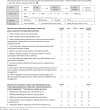Perceptions of Infusion Pump Alarms: Insights Gained From Critical Care Nurses
- PMID: 30188453
- PMCID: PMC6125754
- DOI: 10.1097/NAN.0000000000000295
Perceptions of Infusion Pump Alarms: Insights Gained From Critical Care Nurses
Abstract
Between 1983 and 2011, equipment-related alarms in critical care have increased from 6 to 40 different alarm types. As nurses become overwhelmed, distracted, or desensitized by alarm noise, they may miss critical alarms that could result in patient harm. The findings of an infusion pump alarm survey indicated that nurses overwhelmingly agree that infusion pump nuisance alarms occur frequently and disrupt patient care. But nurses' perceptions of pump alarms are different from those previously reported for clinical alarms in general. It may not be appropriate to broadly apply general alarm management recommendations to infusion pump alarms at this time.
References
-
- Ryan KM, Gagnon M, Hanna T, Mellow B. Noise pollution: do we need a solution? An analysis of noise in a cardiac care unit. Prehosp Disaster Med. 2016;31(4):432–435. - PubMed
-
- Berglund B, Lindval T, Schwela DH; World Health Organization. Occupational and Environmental Health Team. Guidelines for Community Noise. Geneva, Switzerland: World Health Organization; 1999. http://www.who.int/iris/handle/10665/66217. Accessed June 6, 2017.
-
- Kurnat-Thoma E, Shah K. A community hospital's evaluation of alarm management safety factors. J Nurs Adm. 2016;46(12):675–682. - PubMed
-
- Tegnestedt C, Günther A, Reichard A, et al. Levels and sources of sound in the intensive care unit—an observational study of three room types. Acta Anaesthesiol Scand. 2013;57(8):1041–1050. - PubMed
-
- IAC Acoustics. Comparative examples of noise levels. http://www.industrialnoisecontrol.com/comparative-noise-examples.htm. Accessed June 6, 2017.
MeSH terms
LinkOut - more resources
Full Text Sources
Other Literature Sources
Medical
Research Materials


